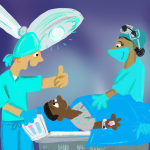It’s OK if you’re feeling overwhelmed right now.
 Jane, our support specialist for London and the South East, shares some tips for managing your emotions as lockdown eases:
Jane, our support specialist for London and the South East, shares some tips for managing your emotions as lockdown eases:
However you’re feeling right now, remember that there’s no ‘normal’ way to feel about the current situation as it changes and evolves. Change can be challenging, even if we’re being told by others in the media or perhaps by friends and family that it’s ‘positive’.
I know from speaking to many of you that some of you are desperate to be reunited with family members who you have missed dreadfully, and this is very exciting! However I also know that many of you are feeling anxious about an expectation of going out into the world again, of the world feeling less safe than it used to; or being worried about being expected to return to work. Your feelings may also be affected by things that are entirely beyond your control, or your thoughts on the matter may change from day to day; and that’s fine.
It can be useful to consider how you are feeling and sit with these feelings for a while. Just because a feeling is ‘negative’ or uncomfortable, doesn’t mean that it needs to be dismissed or batted away.
Try to focus on the things that you can control, and let go of the things that you can’t.
Easier said than done, eh? However if you can identify the root cause of a feeling that’s causing you difficulty, this may help you to manage it. By trying to objectively only give your focus to the things that you can control, this can help manage anger or other emotions arising from the uncontrollable.
Perhaps you’re feeling angry because you’re observing that others aren’t social distancing, for example? You can’t change the actions of others but you can limit your exposure to the things that are creating it. In this example, you could try limiting the amount of news coverage that you consume so that you aren’t exposed to stories highlighting such behaviour.
If you’ve recognised that you need support to let go of things that you can’t control, do get in touch if you want to book in a one to one coaching session.
Join us for our Coping When You’re Overwhelmed webinar to learn some useful tips and explore strategies to get you feeling more in control.
Express yourself through creativity
You may have seen Anita’s story on our website. Anita has coped with her brain tumour diagnosis through creativity, and below you’ll see some quotes from others who have taken a similar approach. Try writing or drawing about how you are feeling – you’ll be surprised at how much this can help.
Read here about how crafting has helped Sarah to manage her brain tumour related anxiety; and consider coming along to our monthly Art Time online workshop.
Talk about it
Often just talking about and acknowledging how you’re feeling can really help. Talk to a friend, call us on 01983 202405, or come along to one of our online social meetups.
Practice self-care
Gift yourself the time to do something for you. We all know that in the event of a plane crash we’re instructed to put on our own life vest before we can help others – well, day to day life is no different. You are important and self care is a priority. What makes your heart sing? Aim to do at least one thing each day that will bring you joy.





